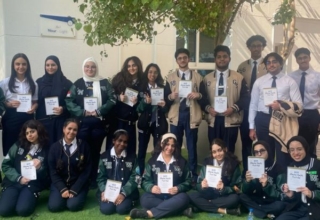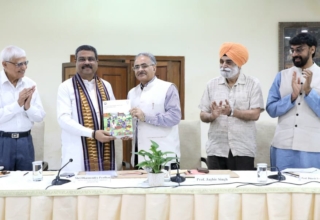
Raft attention to higher education agenda

If much doesn’t change in the draft National Education Policy (NEP) 2019, then university grants commission (UGC) will become Higher Education Grants Council and the regulator function will be vested into a new body to be called as National Higher Education Regulatory Authority. The draft also recommends doubling of government expenditure on public education in next decade and increasing GER in higher education to at least 50% by 2035 among sweeping recommendations to change the face of higher education in India.
This would probably for the first time that higher education has received a rapt attention in a proposed policy document and higher education sector may herald towards a new era of rejuvenation and optimization. The draft contains a major recommendation about formation of a National Education Commission (NEC) or Rashtriya Shiksha Aayog (RSA) to be head by the Prime Minister with the union Human Resources Development minister as the vice-chairperson to look after the education in the country. The HRD ministry is proposed to be addressed as ministry of education in the new scheme.
In order to give the commission or RSA the necessary support and power, approximately 20-30 members comprising of some union ministers, in rotation, whose ministries impact education directly (e.g. health, woman and child development, finance), as well as a few Chief Ministers of States, in rotation, the Principal Secretary to the Prime Minister, the Cabinet Secretary, Vice-Chairperson of the Niti Aayog, the senior-most Secretary in the Ministry of Education, and other such senior bureaucrats/administrators as the government may deem appropriate will form its members. At least 50% of the members will be eminent educationists, researchers and leading professionals from various fields such as arts, business, health , agriculture and social work.
States can appoint a state commission on similar lines. The national higher education regulatory function being discharged by UGC will go to a new National Higher Education Regulatory Authority. Various councils the BCI, ICAR, MCI will lose regulatory tag and remain Professional Standard Setting Bodies (PSSBs). Two councils–General Education Council and Higher Education Grants Council will replace the current UGC if the draft NEP is considered as the final input in this regard. NAAC, NIEPA and NCERT from old order will survive and continue in their current domain areas.
“The RSA through appropriate mechanisms will mentor the evolution of professional education in sync with the rest of higher education. The guiding principle shall be one of looking at higher education in a holistic way and not in a piecemeal fashion. The overall regulatory framework created for higher education will be extended to professional education, and NHERA will remain the sole regulatory authority,” the draft says.
The present complex nomenclature of HEIs in the country as ‘deemed to be university’, ‘affiliating university’, ‘unitary university’, and so on will be phased out. Universities will be characterised only as public, private, or private-aided; and as multidisciplinary research universities (Type 1) or comprehensive teaching universities (Type 2).
Setting up of a National Research Foundation (NRF) to grant competitive funding for outstanding research proposals across all disciplines is another watershed recommendation that will transform the research ecosystem dramatically. The NRF will also act as a liaison among researchers, ministries of government, and industry, in order to ensure that the most relevant and societally useful research reaches the people as soon as possible. The NRF will run a special programme till 2040 to support State Universities to enhance their research capacities, thus enabling them to transition to Type 1 or 2 institutions. Under this programme, the NRF will select and offer 500 National Postdoctoral Fellowships (NPDF) and 500 National Doctoral Fellowships (NDF) every year across disciplines and fields.
According to the draft NEP, the main thrust of this policy regarding higher education is the ending of the fragmentation of higher education by moving higher education into large multidisciplinary universities and colleges, each of which will aim to have upwards of 5,000 or more students.
New institutional architecture for higher education will be based on three kinds of institutions Type 1, Type 2 and Type 3. All HEIs, by 2030, will develop into one of three types of institutions. Type 1 will be Research universities. These will focus equally on research and teaching: they will dedicate themselves to cutting-edge research for new knowledge creation while at the same time offering the highest quality teaching across undergraduate, masters, Ph.D., professional, and vocational programmes. Most central institutions of Higher Education will fall into this category. They will aim to become world-class research universities and compete with global institutions.
Type 2 will be Teaching universities. These will focus primarily on high quality teaching across disciplines and programmes, including undergraduate, masters and doctoral, professional, vocational, certificate and diploma programmes, while also significantly contributing to cutting-edge research. Such institutions will target enrolments between 5,000 and 25,000 or more on their campuses. It is expected that there will be several hundred such universities, say, between 1000 to 2000, created over a period of two decades. As they begin to achieve higher quality in research and the range of programmes offered, some of them may aim to join the ranks of Type 1 institutions.
Type 3 are Colleges. These will focus almost exclusively on the goal of high quality teaching. These institutions will largely run undergraduate programmes, in addition to diploma and certificate programmes, across disciplines and fields, including vocational and professional. A large number of such autonomous colleges, say 5,000–10,000, will provide high quality liberal undergraduate education, with a target of on-campus enrolments of 2,000– 5,000 or higher. These colleges will also be expected to offer certificate, diploma, and degree courses in vocational education, and in some fields of professional education. Given that teaching is strengthened through research and vice-versa, faculty at these colleges will be encouraged to apply for research funding and conduct, and be able to give senior undergraduate students a flavour of research. Over time, such autonomous colleges can begin to conduct quality research across disciplines and introduce graduate programmes, and may thereby aim towards becoming either Type 2 or Type 1 institutions.
Private HEIs will be encouraged to develop into Type 1 and 2 institutions, and must develop to become Type 3 institutions. While the financial support for such development must be arranged by the private HEI, the government will treat them on par with public institutions, and empower them equally. The private HEIs will have equal access to NRF funding for research support as public institutions.
“All HEIs will gradually move towards full autonomy – academic, administrative, and eventually financial – in order to enable this vibrant culture. The autonomy of public institutions will be backed by adequate public financial support and stability. Private institutions with public spirited commitment to high quality, equitable education will be encouraged and treated on par. The new regulatory system envisioned by this Policy will foster this overall culture of empowerment and autonomy to innovate, including by gradually phasing out the system of ‘affiliated colleges’ in order to enable and encourage local innovation.
The overall higher education sector will be integrated into one higher education system – including professional and vocational education. This Policy, its approach, and specific policy points will be equally applicable to all HEIs across all current streams which would eventually merge into one coherent ecosystem of higher education,” the draft says.
ODL (open and distance learning) programmes will be reimagined to ensure that their quality is equivalent to the best in class programmes. A mechanism for the recognition and accumulation of credits earned through MOOCs will be put in place by the GEC as part of the NHEQF. MOOCs offered by universities anywhere in the world will be suitably recognised, after ascertaining the alignment of their contents with the NHEQF, and appropriate checks on their delivery methods, modes of interaction with students, and assessment procedures.
All affiliating universities will transition to a Type 1 or 2 institution, with one or more campuses. Universities will have no affiliated colleges. All (currently) affiliated colleges, must develop into autonomous degree granting colleges (Type 3) by 2032, or merge completely with the university that they are affiliated to, or develop into a university themselves (Type 1 or 2). Special budgets will be allocated to the mentor institutions for this purpose. All higher educational institutions including those offering professional education will be empowered to widen the scope of their course offerings so that each of them becomes a large multidisciplinary institution offering a wide selection of courses.
Again, all HEIs, including all universities (Type 1 and 2), shall be required to offer liberal education undergraduate programmes. Liberal education gets a lot of emphasis in the new draft NEP. Departments of languages (especially Indian languages), literature (especially Indian literature), music (including Carnatic, Hindustani, folk, and film), philosophy (especially Indian philosophy, including Buddhist and Jain philosophy), Indology and the study of India, art, dance, theatre, education, statistics, pure and applied sciences, sociology, economics, sports, and other such departments truly needed for a multidisciplinary and stimulating Indian education and environment will be established and strengthened at HEIs across the country.
Importantly, the long-term vision for the Indian higher education system to ensure that a significant number of high quality Type 1, 2 and 3 institutions are in place by 2030, Mission Nalanda (MN) and Mission Takshashila (MT) will be launched in tandem. These missions will be constituted by the RSA and will have a common apex body – the Mission Directorate. Mission Nalanda will ensure that there are at least 100 Type 1 and 500 Type 2 HEIs functioning vibrantly by 2030, with equitable regional distribution. Mission Takshashila will strive to establish at least one high quality HEI in or close to every district of India, with 2 or 3 such HEIs in districts with larger populations, each with residential facilities for students.
The Policy envisions significant increase in public investment in education. This would go up from the current 10% of overall public expenditure in education to 20%, over a 10-year period. This gradual increase will ensure that as all the actions of this Policy come on stream, adequate funding is made available, while giving the government room to plan and accommodate these increases.
Two important trends of the Indian economy will support these increased investments. First, the rapid pace of economic growth will increase the size of the Indian economy, making it the world’s third largest economy by 2030- 32. The estimated size of the Indian economy (according to NITI Aayog, 2016) then is USD 10 trillion, up from the current USD 2.8 trillion. Second, driven by the systematic measures of the government, the tax-to-GDP ratio is likely to improve, continuing the trend of the past 4 years where it has improved by 1.5%.
At an overall level, e.g. a 1% increase every year, will take public expenditure to 20% in 10 years from the current 10%. Funds must be strategically deployed to improve access to quality education at all levels, from early childhood education to higher education.
From students point of view in changes suggested in the draft: Undertaking a PhD shall require either a Master’s degree or a four-year Bachelor’s degree with Research. The MPhil programme shall be discontinued. Admission to all undergraduate programmes of public HEIs will be through a process of assessment through the NTA. The first year or two of the MBBS course will be designed as a common period for all science graduates after which they can take up MBBS, BDS, Nursing or other specialisations. Common foundational courses based on medical pluralism will be followed by core courses focused on specific systems, and electives that encourage bridging across systems. Graduates from other medical disciplines such as nursing, dental etc., will also be allowed lateral entry into the MBBS course. A medical education qualification framework to achieve this will be developed in conjunction with the NMC.
As per the draft a National Higher Education Qualifications Frame-work (NHEQF) outlining the learning outcomes associated with degree/diploma/certification shall be the guiding document for curricula across all disciplines and fields, which do not have their individual PSSBs. All assessment systems shall be decided by the HEI, including those that lead to final certification. The Choice Based Credit System (CBCS) of the current UGC will be revised and improved, in order to make clear the basic vision while leaving plenty of room for innovation and flexibility. HEIs should move away from high-stakes examinations towards more continuous and comprehensive evaluation.
Setting up of a new National Educational Technology Forum The National Educational Technology Forum will be a platform for the free exchange of ideas on the use of technology to improve learning, assessment, planning and administration. And importantly, the National Repository of Educational Data will maintain all records related to institutions, teachers and students in digital form. The policy draft also recommends setting up of a National Institute for Pali, Persian and Prakrit among a host of measures to enrich higher education.
While overall the draft reflects acceptance of recasting the education systems and provides perspectives of required change, yet a lot will depend on the period between making public of the draft and final announcement of the New Education Policy as debate and final amendments settle.










